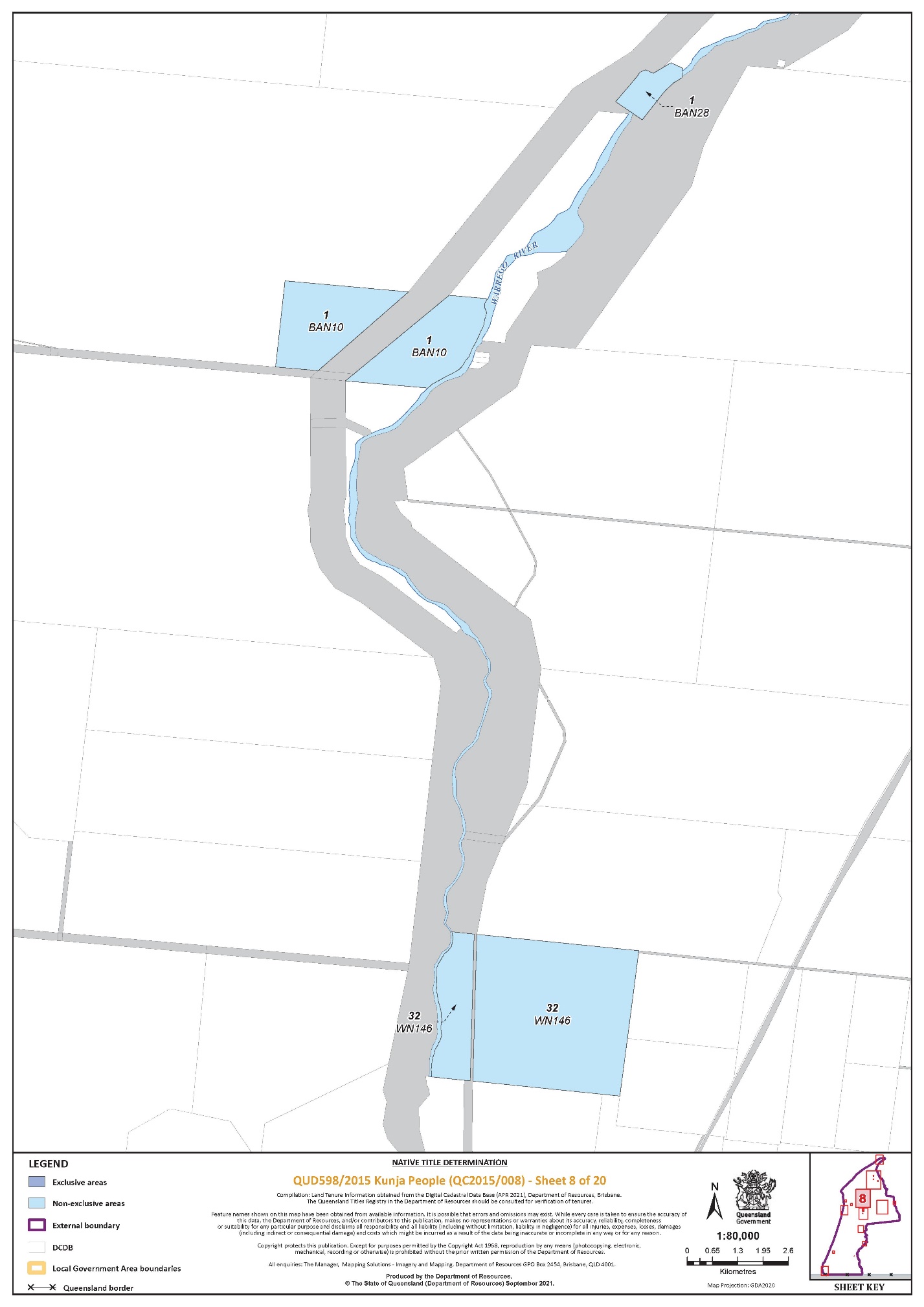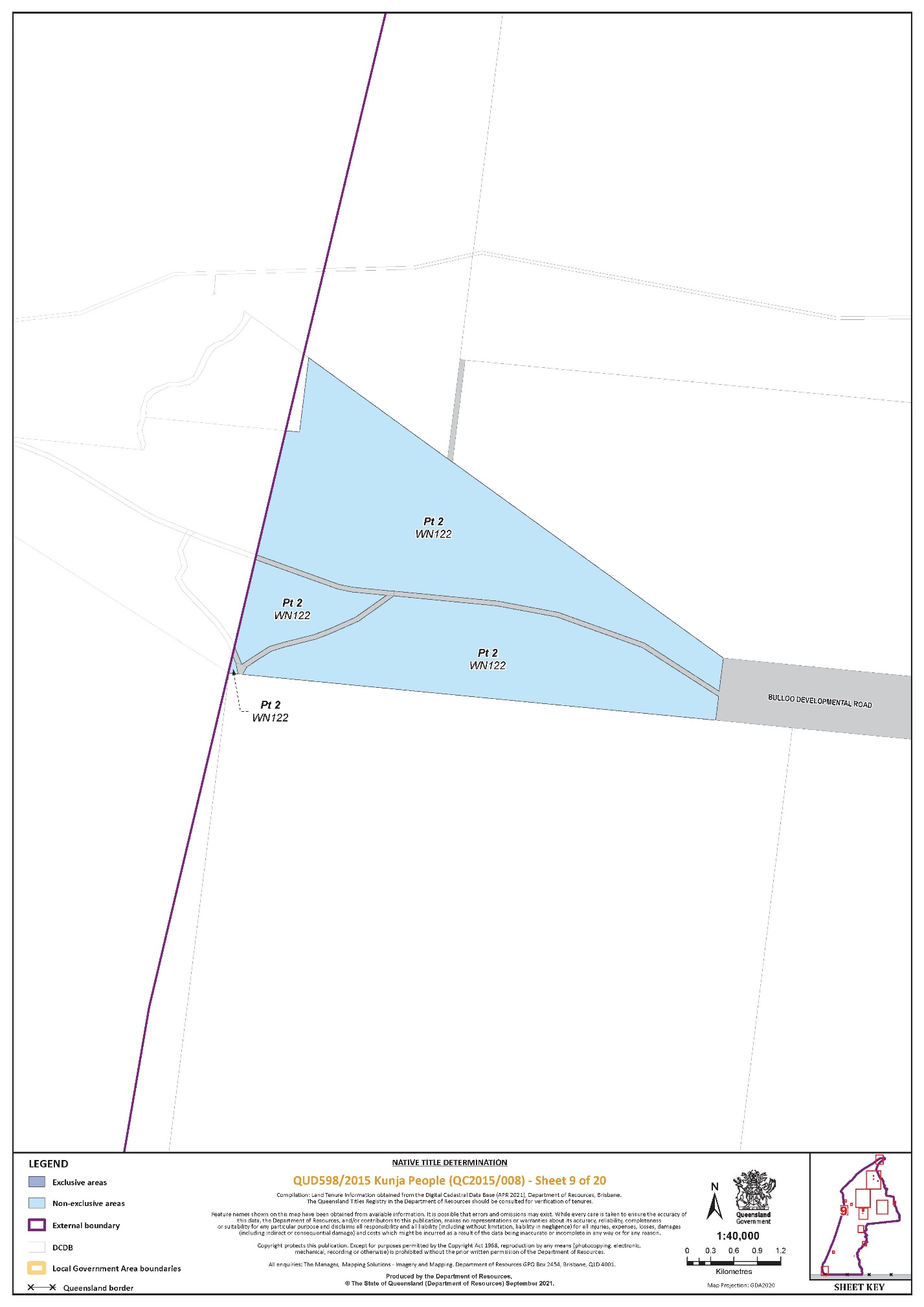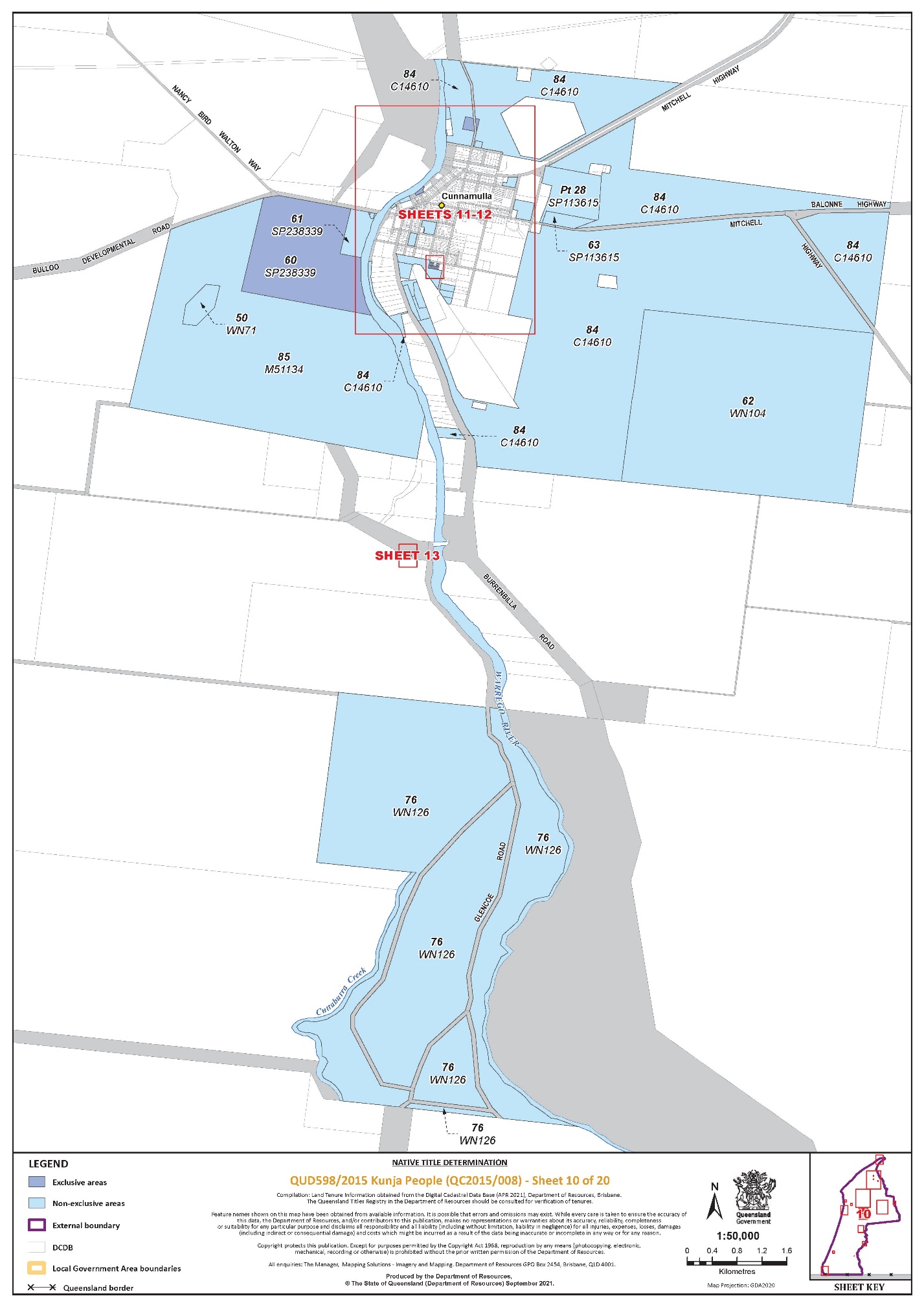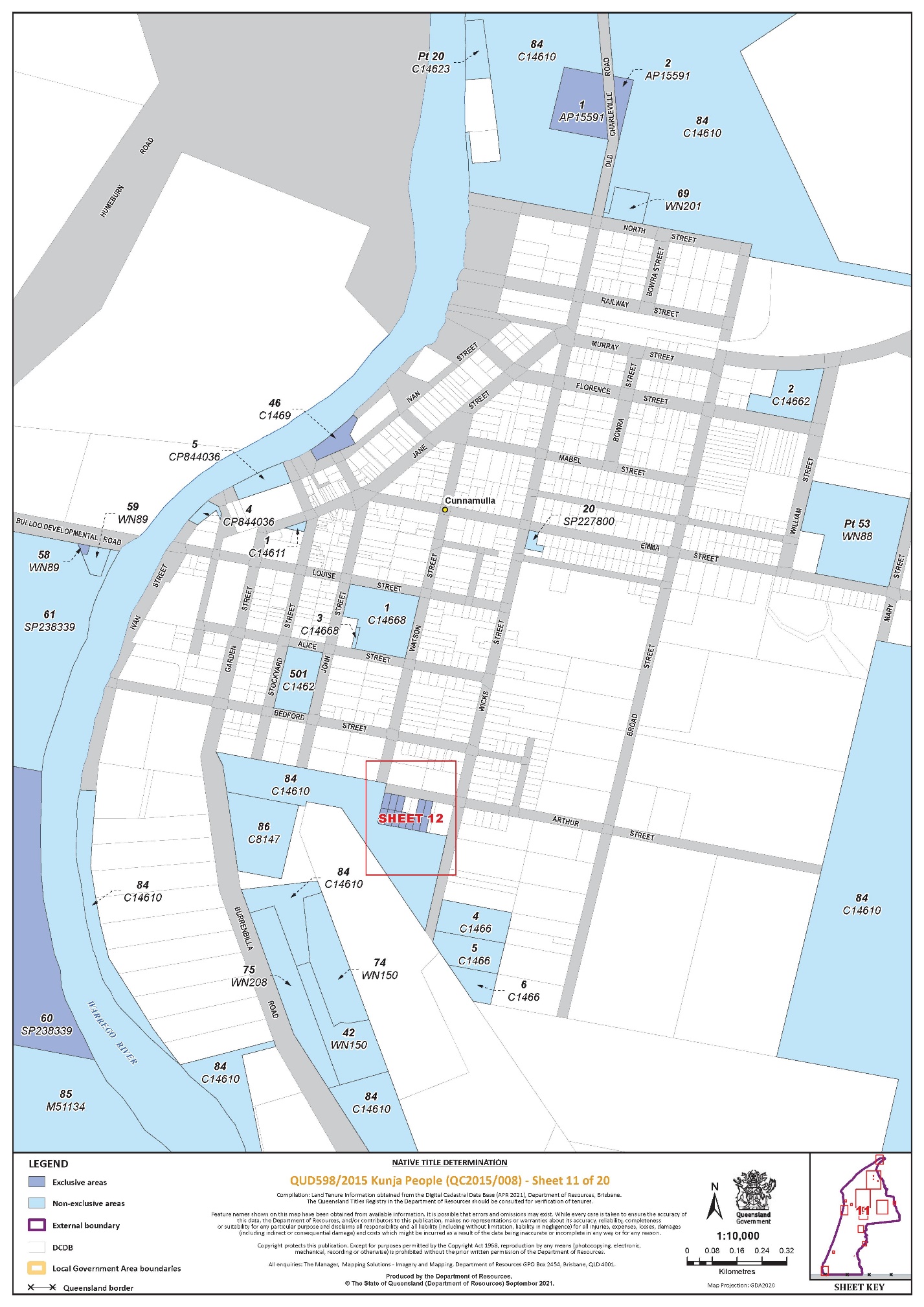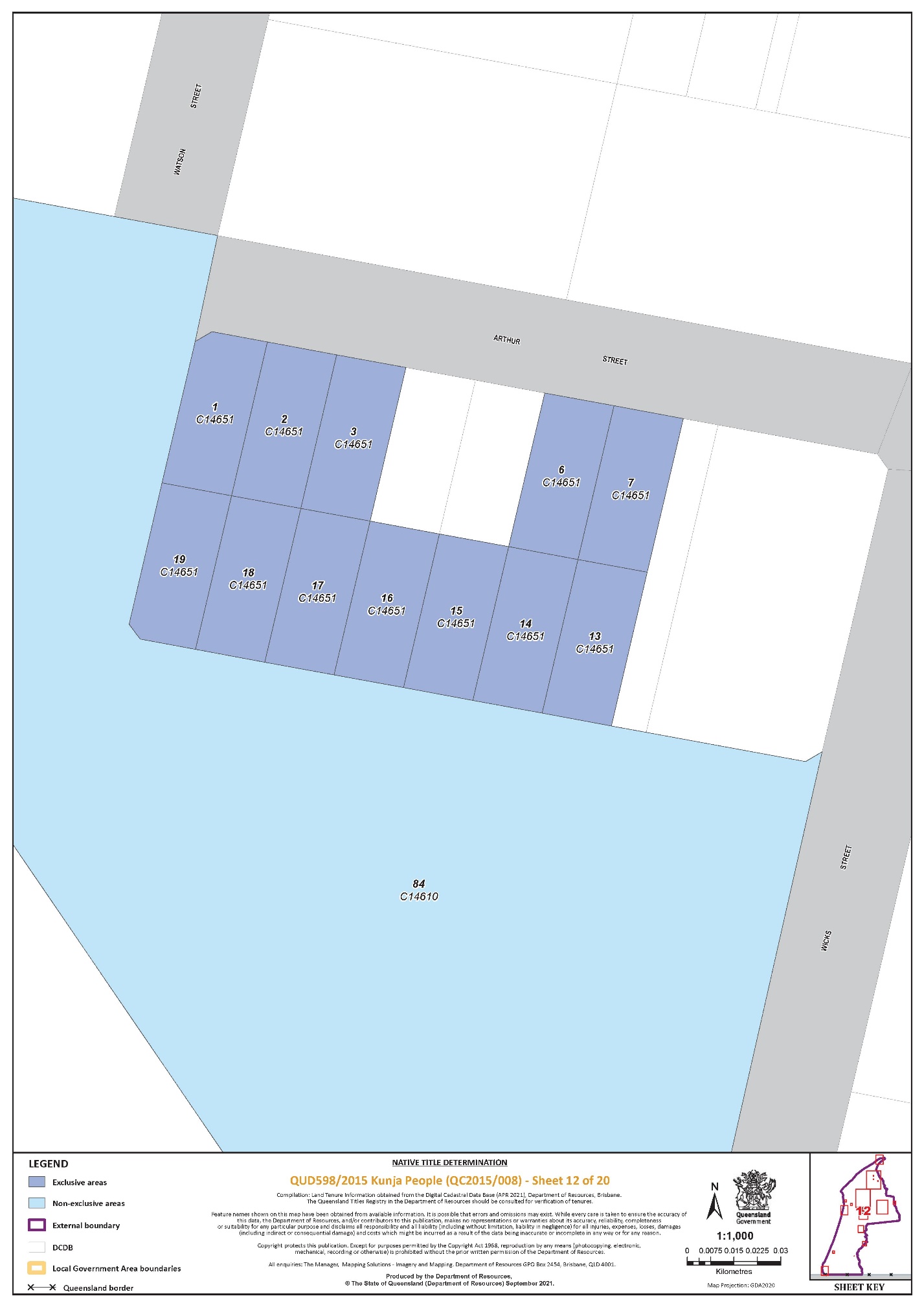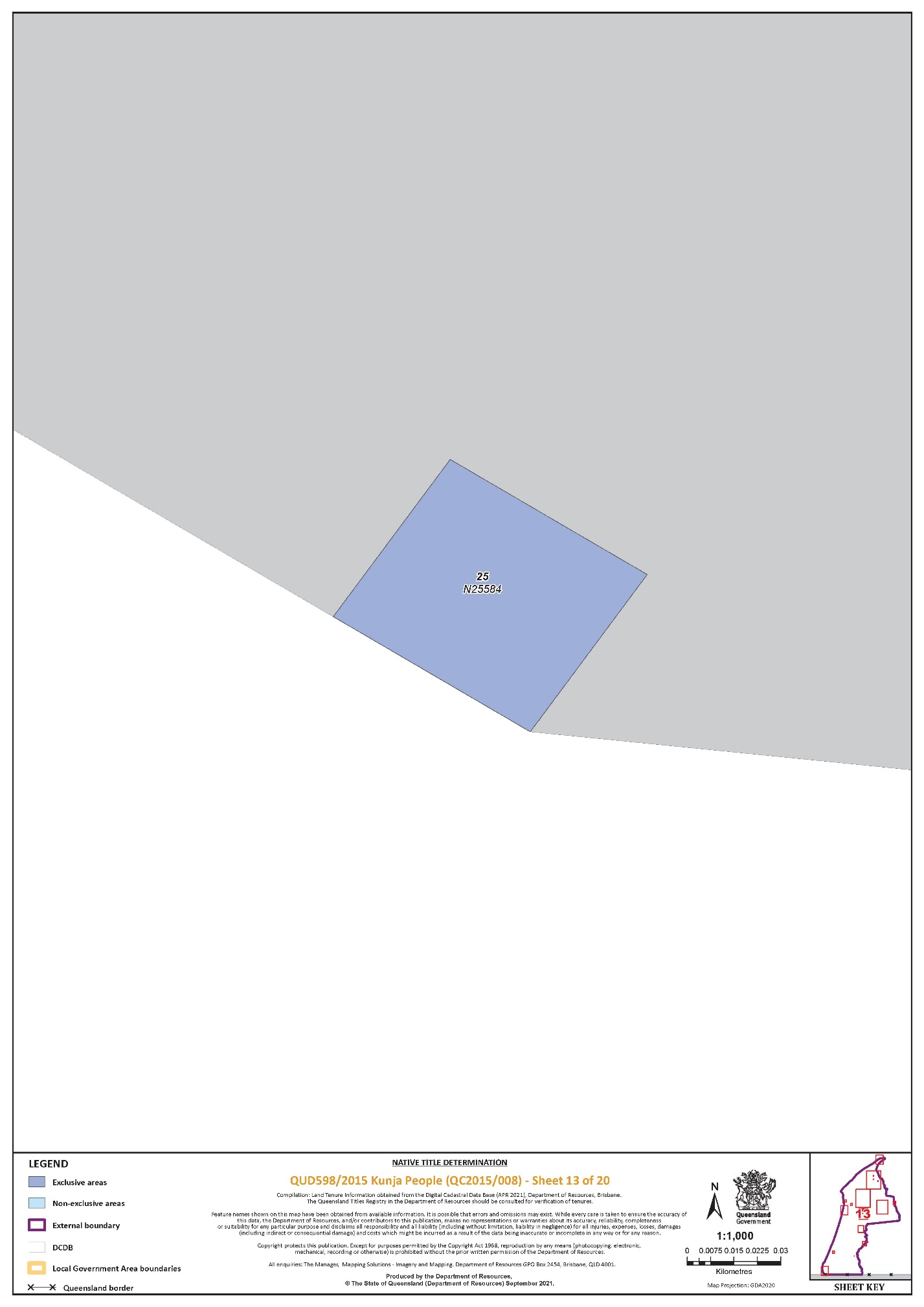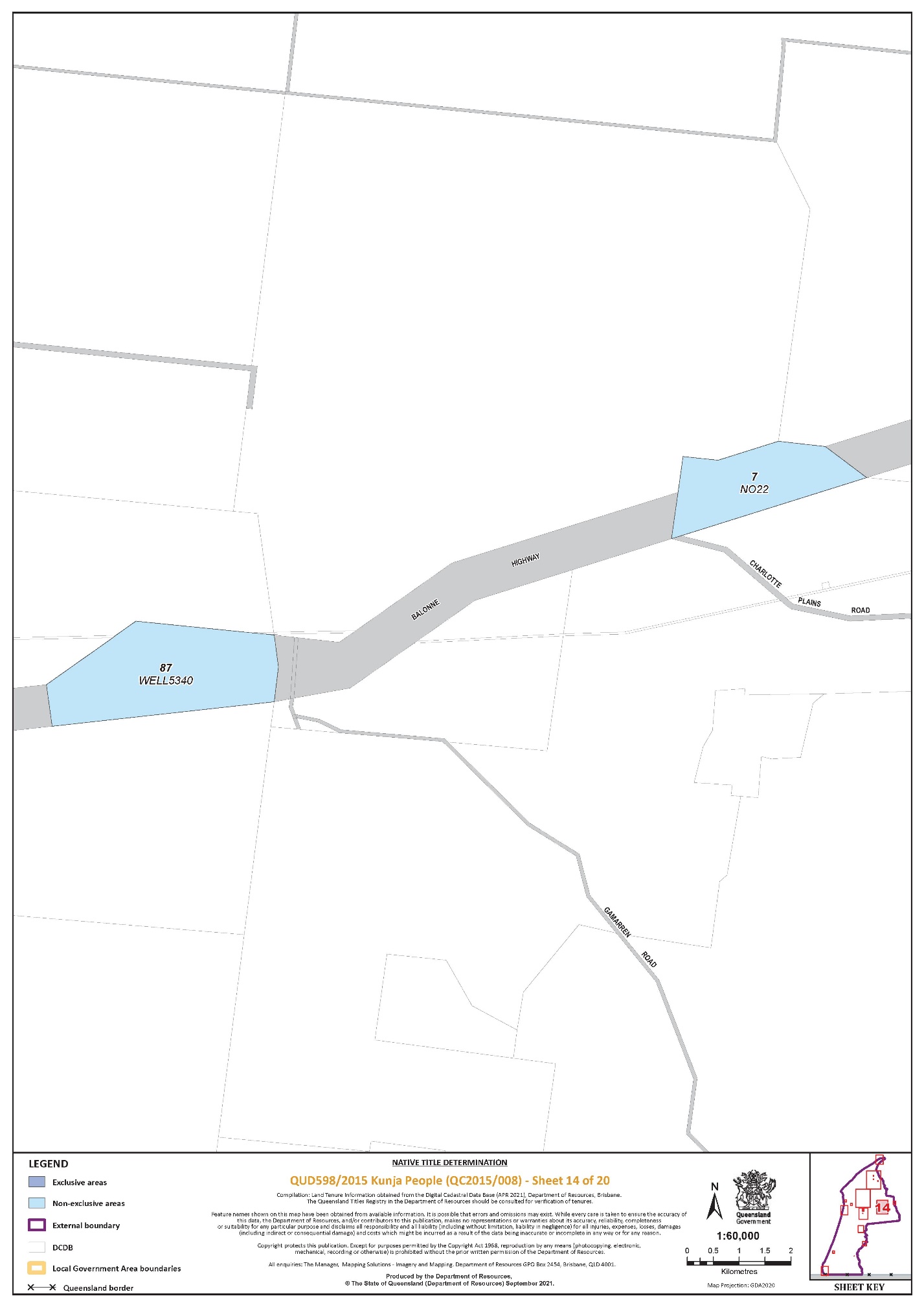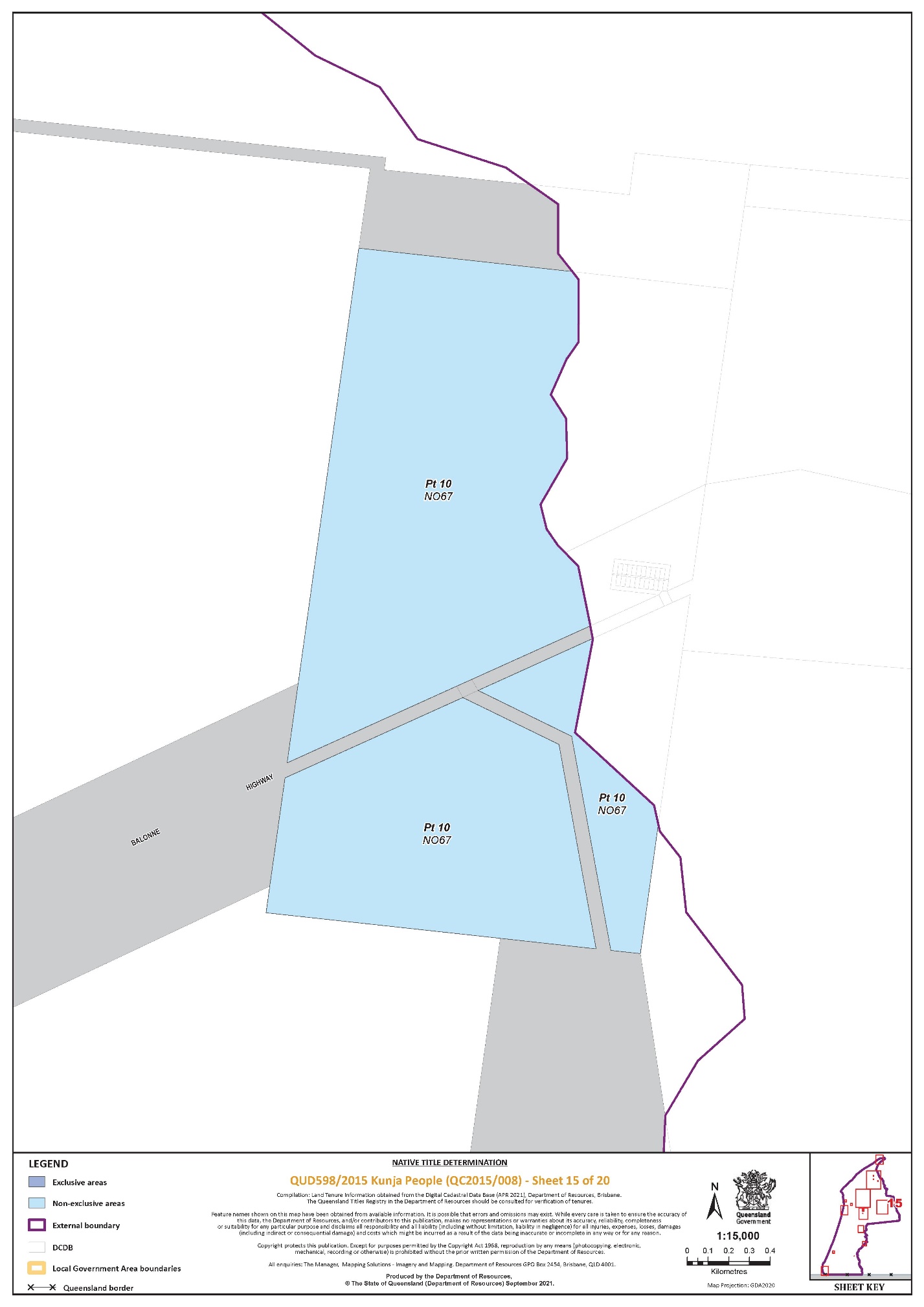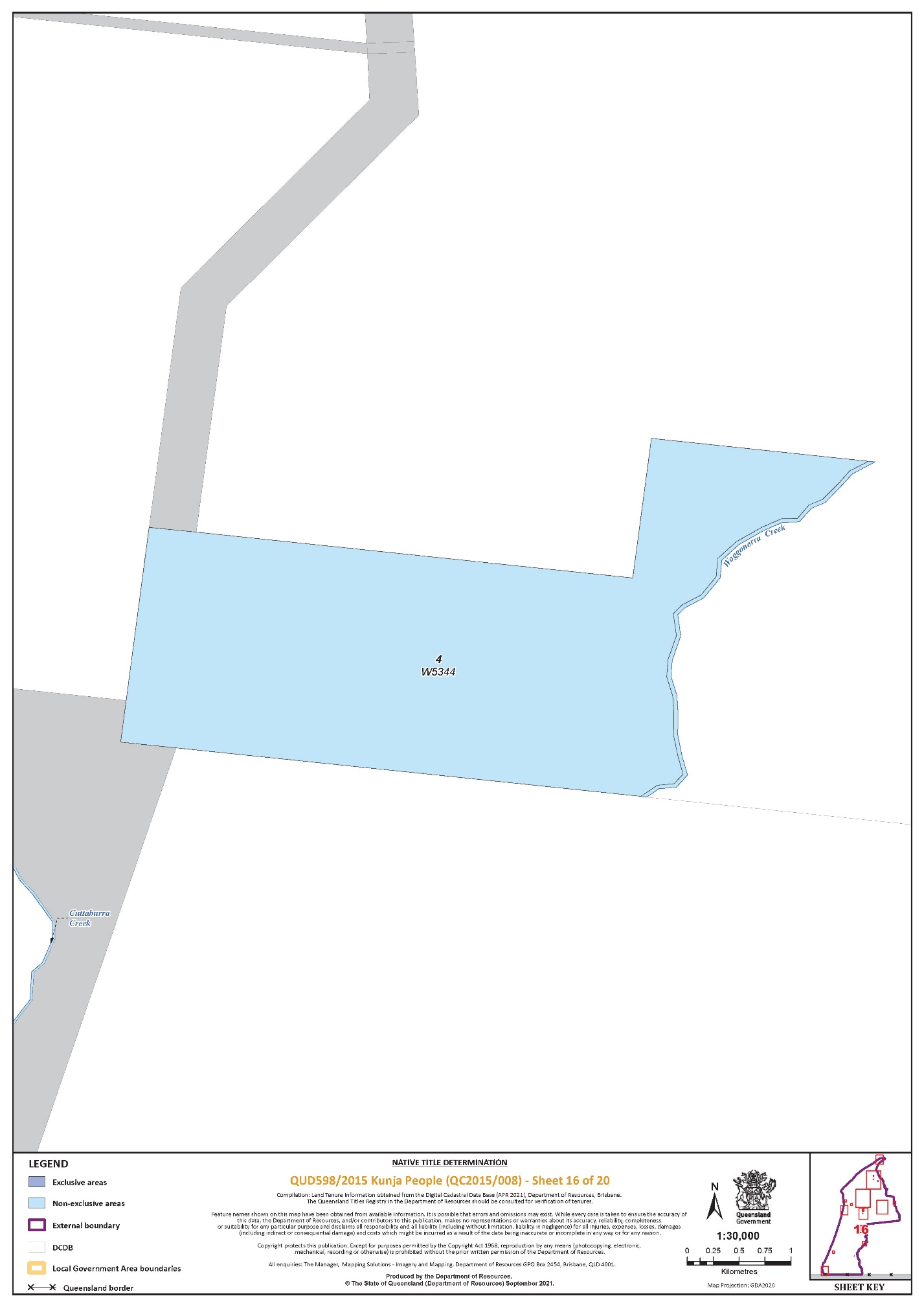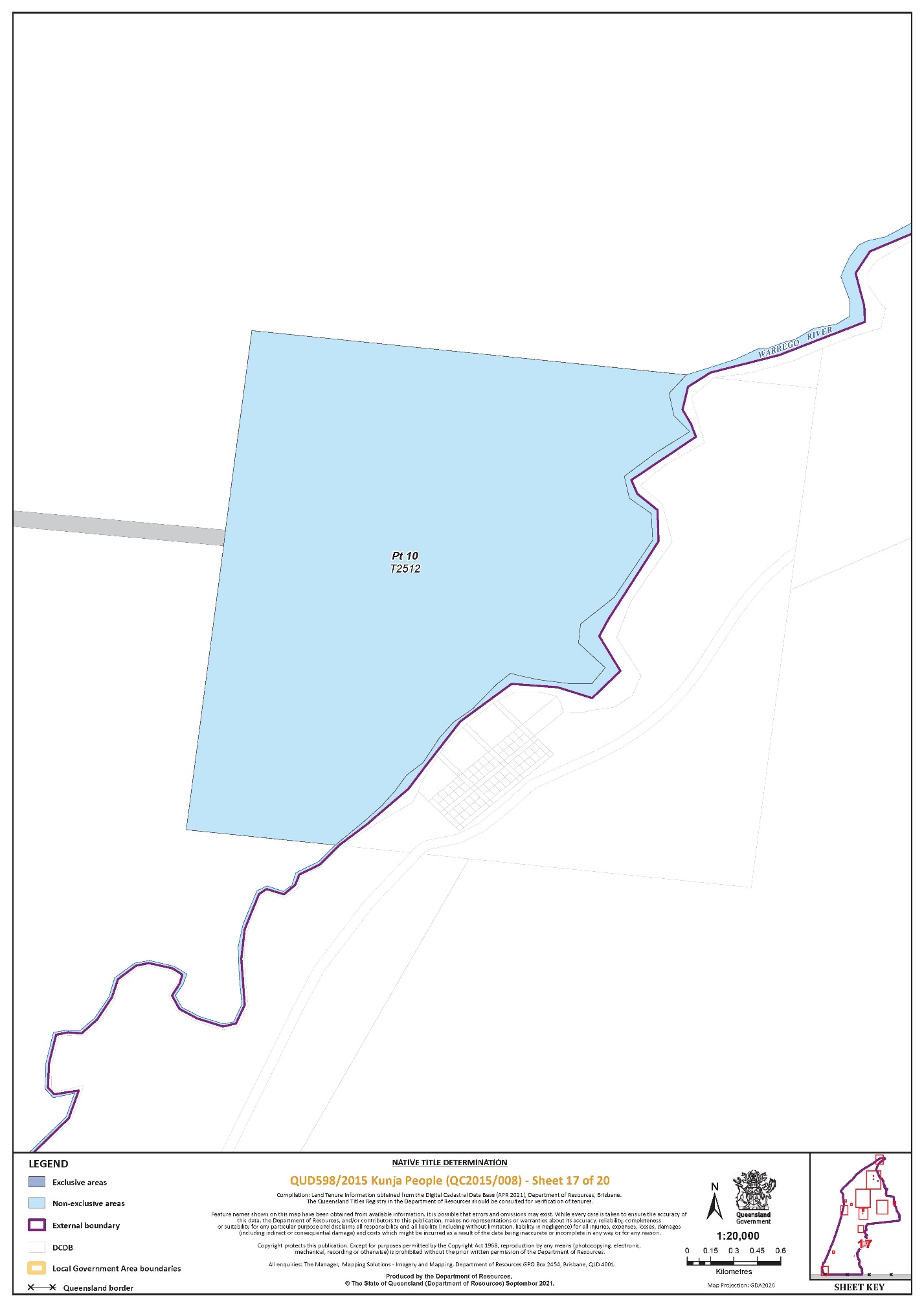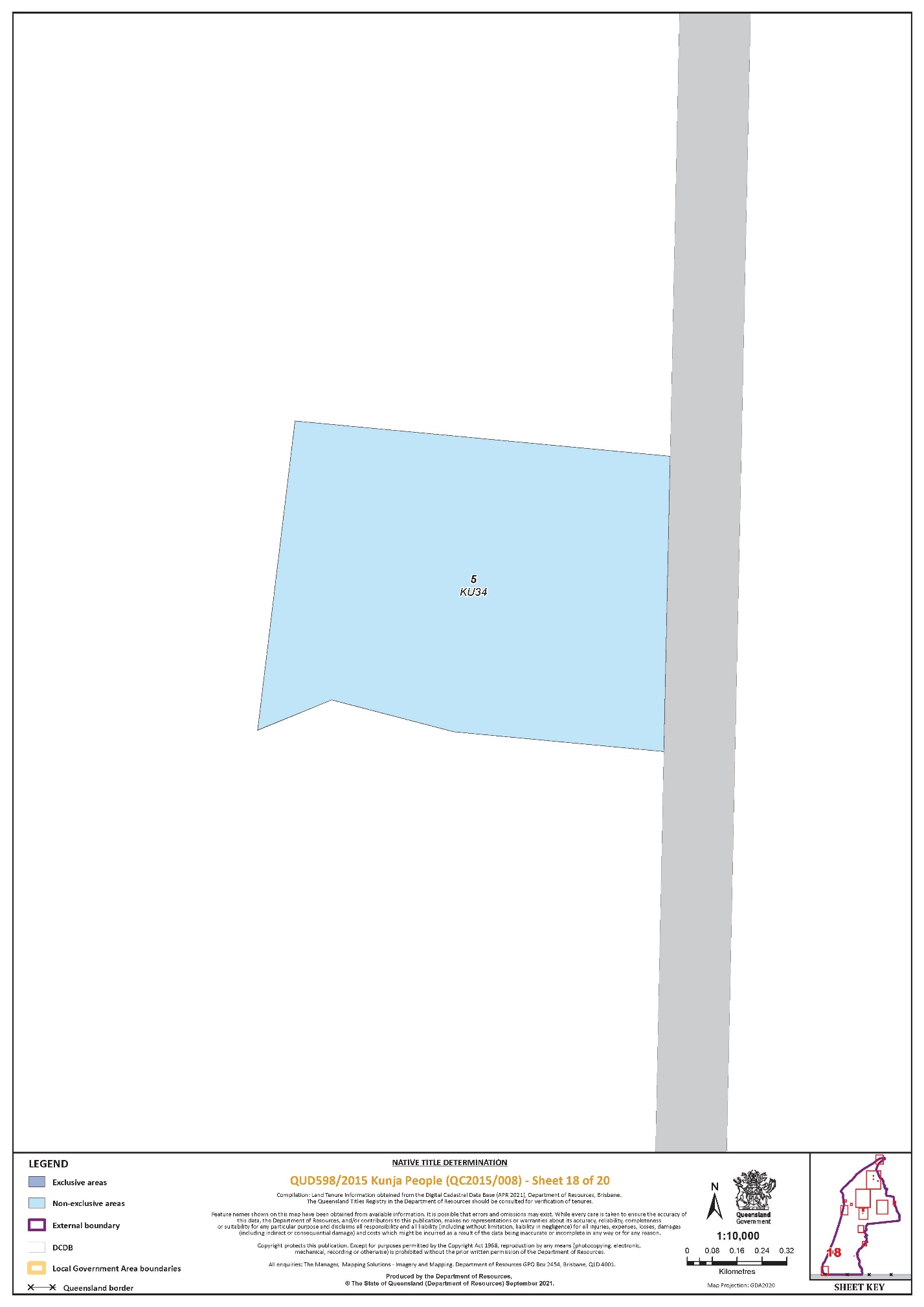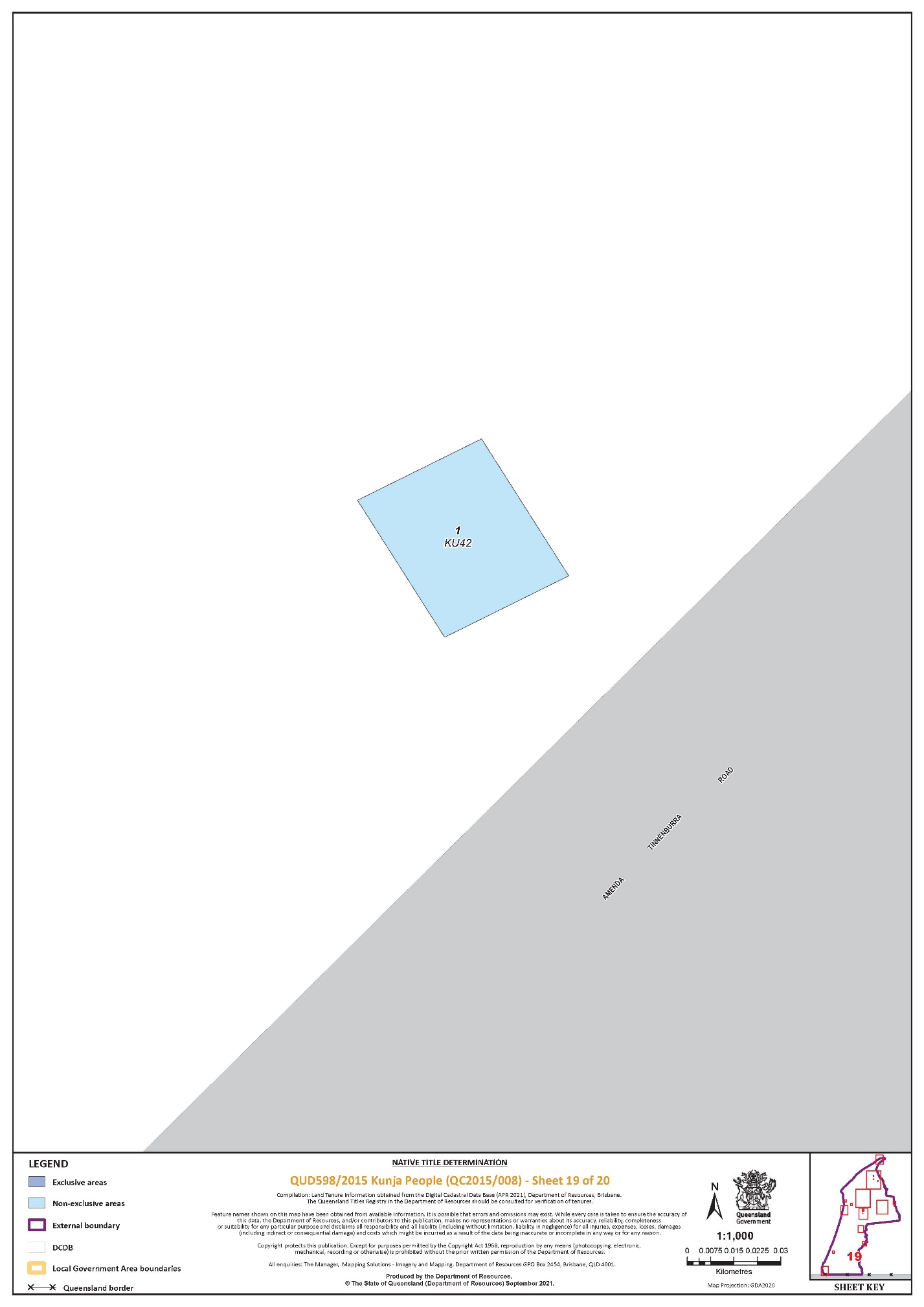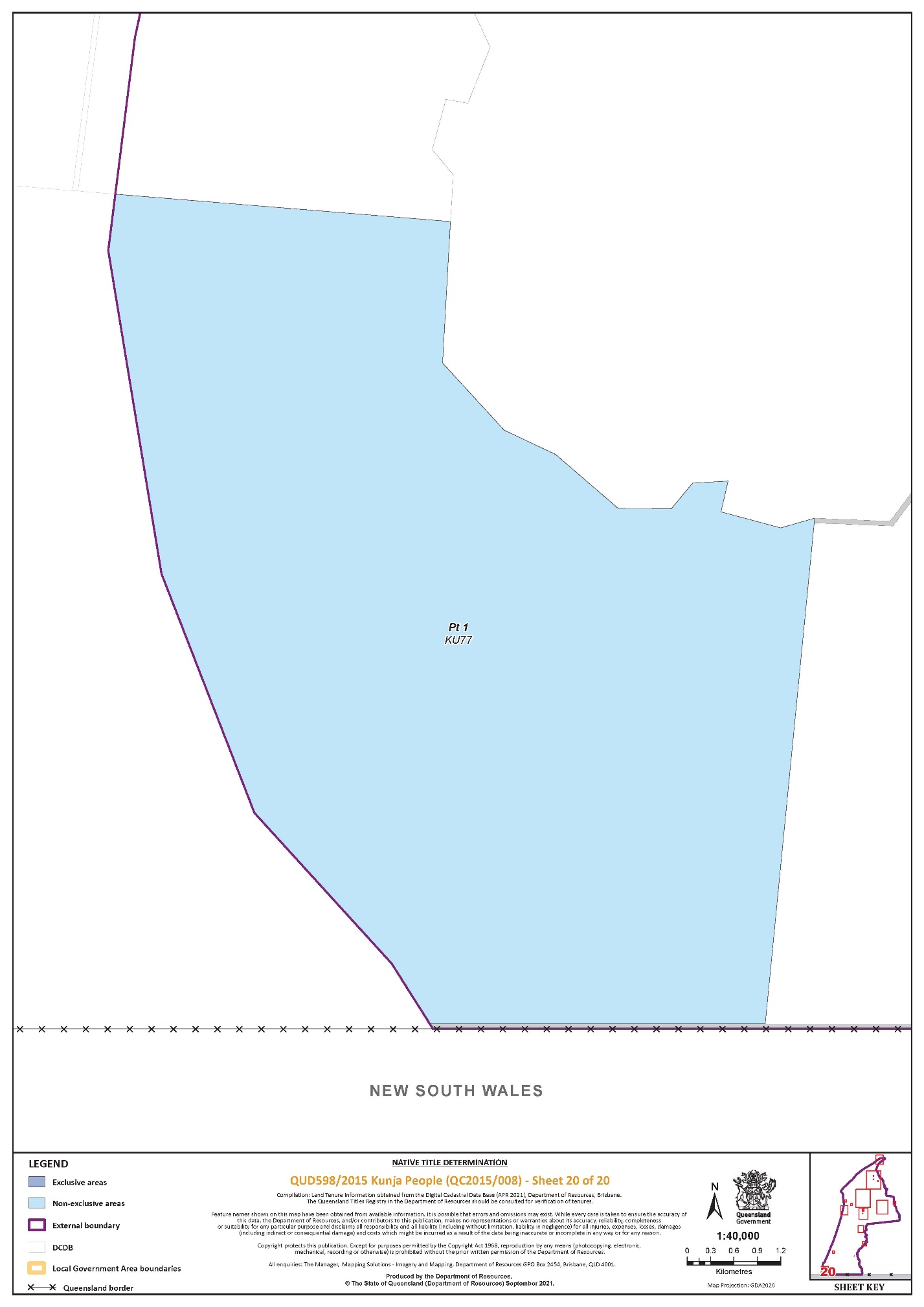FEDERAL COURT OF AUSTRALIA
McKellar on behalf of the Kunja People v State of Queensland [2022] FCA 245
ORDERS
DATE OF ORDER: |
THE COURT NOTES THAT:
A. Having regard to the need to balance the limited availability of public resources with the competing need to resolve applications for a determination of native title in an efficient, cost effective and timely manner, the parties agree that the question of whether s 47C of the Native Title Act 1993 (Cth) (NTA) would apply to any park areas within the External Boundary will be addressed after the matter has proceeded to determination.
B. The Kunja People (being the proposed native title holders described in Schedule 1 of the determination) have indicated a desire to enter into negotiations with the State of Queensland in relation to whether section 47C of the NTA would have application to the land and waters within Lot 4 on KU40 (being a park area which is excluded from the Determination Area) (the park area).
C. Subject to paragraph D below, the Applicant and the State agree that, if agreement is reached in accordance with s 47C(1)(b) of the NTA that s 47C is applicable to the park area, the State of Queensland would not oppose a new application being brought on behalf of the Kunja People pursuant to s 13(1)(a) of the NTA, for a determination that native title exists in relation to the park area.
D. The agreement of the State of Queensland in paragraph C above not to oppose an application for a determination that native title exists in relation to the park area is subject to the Kunja People and the State of Queensland having reached agreement on the nature and extent of the native title rights and interests that would be determined to exist in relation to the park area.
BEING SATISFIED that an order in the terms set out below is within the power of the Court, and it appearing appropriate to the Court to do so, pursuant to s 87 of the Native Title Act 1993 (Cth).
BY CONSENT THE COURT ORDERS THAT:
1. There be a determination of native title in the terms set out below (the determination).
2. Each party to the proceedings is to bear its own costs.
BY CONSENT THE COURT DETERMINES THAT:
3. The determination area is the land and waters described in Schedule 4 and depicted in the map attached to Schedule 6 to the extent those areas are within the External Boundary and not otherwise excluded by the terms of Schedule 5 (the Determination Area). To the extent of any inconsistency between the written description and the map, the written description prevails.
4. Native title exists in the Determination Area.
5. The native title is held by the Kunja People described in Schedule 1 (the Native Title Holders).
6. Subject to orders 8, 9 and 10 below the nature and extent of the native title rights and interests in relation to the land and waters described in Part 1 of Schedule 4 are:
(a) other than in relation to Water, the right to possession, occupation, use and enjoyment of the area to the exclusion of all others; and
(b) in relation to Water, the non-exclusive rights to:
(i) hunt, fish and gather from the Water of the area;
(ii) take the Natural Resources of the Water in the area; and
(iii) take the Water of the area,
for personal, domestic and non-commercial communal purposes.
7. Subject to orders 8, 9 and 10 below the nature and extent of the native title rights and interests in relation to the land and waters described in Part 2 of Schedule 4 are the non-exclusive rights to:
(a) access, be present on, move about on and travel over the area;
(b) camp, and live temporarily on the area as part of camping, and for that purpose build temporary shelters on the area;
(c) hunt, fish and gather on the land and waters of the area for personal, domestic and non-commercial communal purposes;
(d) take Natural Resources from the land and waters of the area for personal, domestic and non-commercial communal purposes;
(e) take the Water of the area for personal, domestic and non-commercial communal purposes;
(f) conduct ceremonies on the area;
(g) bury Native Title Holders within the area;
(h) maintain places of importance and areas of significance to the Native Title Holders under their traditional laws and customs and protect those places and areas from physical harm;
(i) teach on the area the physical, cultural and spiritual attributes of the area;
(j) hold meetings on the area; and
(k) light fires on the area for domestic purposes including cooking, but not for the purpose of hunting or clearing vegetation.
8. The native title rights and interests are subject to and exercisable in accordance with:
(a) the Laws of the State and the Commonwealth; and
(b) the traditional laws acknowledged and traditional customs observed by the Native Title Holders.
9. The native title rights and interests referred to in orders 6(b) and 7 do not confer possession, occupation, use or enjoyment to the exclusion of all others.
10. There are no native title rights in or in relation to minerals as defined by the Mineral Resources Act 1989 (Qld) and petroleum as defined by the Petroleum Act 1923 (Qld) and the Petroleum and Gas (Production and Safety) Act 2004 (Qld).
11. The nature and extent of any other interests in relation to the Determination Area (or respective parts thereof) are set out in Schedule 2.
12. The relationship between the native title rights and interests described in orders 6 and 7 and the other interests described in Schedule 2 (the Other Interests) is that:
(a) the Other Interests continue to have effect, and the rights conferred by or held under the Other Interests may be exercised notwithstanding the existence of the native title rights and interests;
(b) to the extent the Other Interests are inconsistent with the continued existence, enjoyment or exercise of the native title rights and interests in relation to the land and waters of the Determination Area, the native title continues to exist in its entirety but the native title rights and interests have no effect in relation to the Other Interests to the extent of the inconsistency for so long as the Other Interests exist; and
(c) the Other Interests and any activity that is required or permitted by or under, and done in accordance with, the Other Interests, or any activity that is associated with or incidental to such an activity, prevail over the native title rights and interests and any exercise of the native title rights and interests but will not extinguish them except in relation to acts that consist of the construction or establishment of a valid public work, done after this determination where s 24JA of the Native Title Act 1993 (Cth) applies.
DEFINITIONS AND INTERPRETATION
13. In this determination, unless the contrary intention appears:
“External Boundary” means the area described in Schedule 3;
"land" and "waters", respectively, have the same meanings as in the Native Title Act 1993 (Cth);
"Laws of the State and the Commonwealth" means the common law and the laws of the State of Queensland and the Commonwealth of Australia, and includes legislation, regulations, statutory instruments, local planning instruments and local laws;
“Local Government Act” has the meaning given in the Local Government Act 2009 (Qld);
“Local Government Area” has the meaning given in the Local Government Act 2009 (Qld);
"Natural Resources" means:
(a) any animal, plant, fish and bird life found on or in the lands and waters of the Determination Area; and
(b) any clays, soil, sand, gravel or rock found on or below the surface of the Determination Area,
that have traditionally been taken and used by the Native Title Holders, but does not include:
(a) animals that are the private personal property of another;
(b) crops that are the private personal property of another; and
(c) minerals as defined in the Mineral Resources Act 1989 (Qld); or
(d) petroleum as defined in the Petroleum Act 1923 (Qld) and the Petroleum and Gas (Production and Safety) Act 2004 (Qld);
“Reserve” means a reserve dedicated or taken to be a reserve under the Land Act 1994 (Qld);
"Water" means:
(a) water which flows, whether permanently or intermittently, within a river, creek or stream;
(b) any natural collection of water, whether permanent or intermittent; and
(c) water from an underground water source;
“Works” has the same meaning as in the Electricity Act 1994 (Qld).
Other words and expressions used in this determination have the same meanings as they have in Part 15 of the Native Title Act 1993 (Cth).
THE COURT DETERMINES THAT:
14. The native title is held in trust.
15. The Kunja Aboriginal Corporation (ICN: 9600), incorporated under the Corporations (Aboriginal and Torres Strait Islander) Act 2006 (Cth), is to:
(a) be the prescribed body corporate for the purpose of ss 56(2)(b) and 56(3) of the Native Title Act 1993 (Cth); and
(b) perform the functions mentioned in s 57(1) of the Native Title Act 1993 (Cth);
(c) after becoming a registered native title body corporate.
Note: Entry of orders is dealt with in Rule 39.32 of the Federal Court Rules 2011.
SC DERRINGTON J:
Introduction
1 Ms Maureen McKellar, and others on behalf of the Kunja People (Applicant), seek orders under s 87 of the Native Title Act 1993 (Cth) (NTA) for a determination of native title which gives effect to the terms of an agreement reached between the parties (s 87 Agreement) including Draft Consent Determination Orders (Draft Orders). The persons comprising the representative Applicant are Ms McKellar, Gertrude Darrigo, June Derrick, Rhyannon Meredith, Stephen Howarth, John Barker, Diane Dawn Edwards, and Julie Fox.
2 The claim is over land located in the South West Queensland region with the town of Cunnamulla at its centre (Application Area).
3 The parties have indicated their consent to a determination that the Kunja People are the holders of native title in the area covered by the Application Area.
4 For the reasons set out below, the Court is satisfied that it is within the power of the Court to make the orders sought, and that it is appropriate to do so.
5 As will be explained, the Court’s task in reaching the required state of satisfaction to make a determination of native title under s 87 of the NTA is based on the parties’ free and informed agreement and so does not require judicial determination of the issues in the application. In making such a determination, the Court recognises that rights and interests have existed under the traditional laws and customs of the Kunja People for millennia. The effect of the determination is that the Australian community will collectively recognise that those rights which existed at sovereignty, and which survived that fundamental change in legal regime, are enforced and protected pursuant to the NTA. For that reason, and consistent with the Preamble to the NTA, it is appropriate to record some of the history, prior rights and interests, and rich and diverse culture of the Kunja People that was in evidence before this Court and which is described as the Connection Material.
The Kunja People
6 The Kunja People are described in Schedule 1 of the Draft Orders. They are descendants (including those descended by rearing up) who are recognised and accepted in accordance with traditional law and custom of the following ancestors:
(a) Killamunda (including her children, Margaret Turner (Granny McKellar), Annie/Nannie Widgell and Jack Brennan);
(b) Unnamed mother of Flora Maranoa;
(c) Maria Major (including her children, Jack Oliffe, Ron Wyman, Walter Wyman and Lila Lynett); or
(d) Jimmy Nyngan.
7 The submissions before the Court provide that the Connection Material establishes:
(a) that the Kunja People were a group that belonged to a regional society comprised of groups that shared and observed a similar system of laws and customs. Tribal groups within the regional society were linked through marriage, trading networks, a common system of kinship, moiety and section divisions, totemism and ceremonial gatherings.
(b) that the Kunja People today are descended from the identified apical ancestors who were the people occupying the area at first contact and are the ‘old people’ who held the inalienable rights and interests in the communal land and waters of Cunnamulla and its surroundings;
(c) that early ethnographic records characterised the Kunja people as what is today known as a ‘language name tribe’, which is a territorial and social group that takes its tribal name from its own language. The Kunja identity plays a significant role in Kunja People distinguishing themselves as separate from others within the regional society such as Budjiti, Kooma, and Muruwari. Language identity is related to territorial recognition with membership descended from forebears who were members of the same ‘language name group’ or otherwise affiliated with that territory;
(d) although transmission of identity was traditionally patrilineal, post-colonisation the system has been adapted to a more flexible system and Kunja descendants of the apical ancestors obtain their identity rights and interests in the Application area through either their mother or their father or both. Adoption, ‘rearing up’ or ‘growing up’ children is also a mechanism for membership to the group and consequently the inheritance of rights and interests in country;
(e) filiation has continued to be how people acquire rights and interests to land and knowledge of country;
(f) despite the impacts of colonisation and removal from Kunja country, the Kunja People have retained their common identity and have demonstrated continuity in the observance and practice of their traditional laws and customs, the knowledge of which has been passed from generation to generation. This includes effective maintenance of: beliefs in the mythological era as the ultimate source of Aboriginal law and custom; filiation as the mechanism for the acquisition of identity along with rights and interests in land and transmission of knowledge; the sacred nature of people’s connection to country; the land belongs collectively to the language-named tribe; elders hold ultimate authority in the community including to make decisions about country;
(g) Kunja People continue to have knowledge of myths and associated sites, and their relationship to country continues to be mediated by their spiritual beliefs. These include their relationship with the ‘old people’, which mandates behaviours such as addressing, talking to, and introducing themselves to the ‘old people’ when visiting sites, and knowing the Moondagutta ‘rainbow serpent story’ and the Gulliemudgin and Goongarnie Dreamtime story;
(h) ceremony is key to holding the network of the regional society alive and corroborees and ceremonies involving groups within the regional society were widely practised within the 20th century;
(i) pre-sovereignty, the Kunja People had a system of matrifilial moiety totems of which one version has survived. Kunja People today recognise the bilby as the totem of the tribe as a whole and continue to observe the regulatory proscriptions against eating or harming their own totem;
(j) the Kunja People hold the right to possess, occupy, use, and enjoy the Application area to the exclusion of all others under their traditional laws and customs. It is expected that non-Kunja People will seek permission from Kunja People before accessing and using Kunja country with their being consequences for breaching the permission system;
(k) in relation to traditional land and waters, the Kunja People continue to exercise: the right to occupy, move about, and travel over it; to camp and build shelters on it; to hunt, fish, and gather on it; to take natural resources from it; to conduct ceremonies on it; to bury native title holders within it; to maintain places of importance and protect them from physical harm; to teach the physical, cultural, and spiritual attributes of it; to hold meetings on it, and to light fires on it.
The Determination Area
8 The Determination Area is generally described above. It is defined in Order 3 of the Draft Orders by reference to written description of the land and waters in Schedules 4, and depicted in the map attached to Schedule 6.
The process towards a consent determination
9 The Applicant filed the Kunja Application on 17 July 2015. It was referred to the Native Title Registrar who accepted the Application for registration under s 190A of the NTA. The Application was entered on the Register of Native Title Claims on 19 November 2015, and notice was given by the Native Title Registrar under s 66 on 24 February 2016. The closing date for the notification period was 23 May 2016.
10 The Application has since been amended pursuant to orders of the Court. First, by Amended Application filed on 16 April 2018 to, amongst other things replace the original applicant and to change the claim area boundary as authorised on 4 February 2018. Secondly, by a Further Amended Application filed on 15 August 2019 to, amongst other things, replace the applicant and to change the claim area boundary as authorised on 25 May 2019. Thirdly, by Second Further Amended Application filed on 14 September 2020 to replace the applicant. Finally, by a Third Further Amended Application filed on 12 May 2021 to replace the applicant.
11 The respondent parties to the Kunja Application are:
(a) The State of Queensland (State)
(b) Paroo Shire Council
(c) Ergon Energy Corporation Limited
(d) Telstra Corporation Limited
(e) Bridgefield Proprietary Limited
(f) Dehli Petroleum Proprietary Limited
(g) Moonie Pipeline Company Proprietary Limited
(h) Beach Energy (Operations) Limited;
(i) Santos Limited;
(j) Vamgas Proprietary Limited
(k) Anne Elizabeth Helen Bredhauer;
(l) Renton Mark Bredhauer; and
(m) Michael Belmore Moody.
12 On 12 September 2016, Rangiah J ordered the matter be referred to the Registrar for case management. As part of that process, the applicant has provided the State with connection material which was assessed by senior counsel and anthropologists engaged by the State in accordance with the Guidelines for preparing and assessing connection material for Native Title Claims in Queensland (dated November 2016). The Paroo Shire Council also conducted an independent assessment.
13 Following the case management process, all parties to the Application reached agreement that native title exists over the area covered by the Application.
14 Subsequently, all parties executed the Section 87 Agreement to which the Draft Orders are annexed. It was filed on 1 February 2022. The Applicant seeks a determination of native title in the terms of the Draft Orders agreed by the parties.
15 The application for a consent determination is supported by the following materials:
(a) the Applicant’s submissions in support of the application.
(b) the summary of the connection material that is Annexure B to the Applicant’s written submissions;
(c) the s 87 Agreement and Draft Orders;
(d) an affidavit of Matthew Eli Waters filed on 25 January 2022.
THE REQUIREMENTS OF SECTION 87
Whether the Court has power to make the proposed orders
16 Pursuant to s 87(1) of the NTA the Court may make a determination of native title by consent without holding a hearing where:
(a) the period specified in the notice given under s 66 of the NTA has ended (s 87(1));
(b) there is an agreement for a proposed determination of native title in relation to the proceeding (s 87(1)(a));
(c) the terms of the proposed determination, in writing signed by or on behalf of all of the parties, is filed with the Court (s 87(1)(b)); and
(d) the Court is satisfied that an order in, or consistent with, those terms would be within the power of the Court (s 87(1)(c)).
17 Having regard to the material before the Court, it is satisfied that:
(a) the notice period specified in s 66 of the NTA ended long ago, on 23 May 2016; and
(b) there is an agreement for a proposed determination of native title in relation to the proceeding, that the terms of the proposed determination are in writing, have been signed on behalf of all of the parties, and have been filed with the Court, on 1 February 2021 (s 87(1)(a) and (b)).
18 An order under s 87 of the NTA will be within power (s 87(1)(c)) if: it is consistent with s 94A of the NTA; the rights and interests included in the proposed determination are recognisable by the common law of Australia; and there is no other native title determination in existence over the area the subject of the proposed determination: Kngwarrey on behalf of the member of the Irrkwal, Ntewerrek, Aharreng, Arrty/Amatyerr and Areyn Landholding Groups v Northern Territory of Australia [2011] FCA 428 at [7].
19 Section 94A provides that an order by which the Court makes a determination of native title must set out details of the matters mentioned in s 225 of the NTA. Section 225 provides:
A determination of native title is a determination whether or not native title exists in relation to a particular area (the determination area) of land or waters and, if it does exist, a determination of:
(a) who the persons, or each group of persons, holding the common or group rights comprising the native title are; and
(b) the nature and extent of the native title rights and interests in relation to the determination area; and
(c) the nature and extent of any other interests in relation to the determination area; and
(d) the relationship between the rights and interests in paragraphs (b) and (c) (taking into account the effect of this Act); and
(e) to the extent that the land or waters in the determination area are not covered by a non-exclusive agricultural lease or a non-exclusive pastoral lease – whether the native title rights and interests confer possession, occupation, use and enjoyment of that land or waters on the native title holders to the exclusion of all others.
20 The Court is satisfied as to each of the matters in s 225, being that:
(a) the persons holding the common or group rights comprising the native title are identified as the Kunja People in Order 5 of the Draft Orders. The Kunja People are the descendants of the ancestors identified in Schedule 1, in accordance with the traditional laws and customs of the Kunja People (s 225(a));
(b) the nature and extent of the native title rights and interests in relation to the Determination Area are set out in Orders 6, 7 and 8 of the Draft Orders (s 225(b));
(c) the nature and extent of any “other interests” in relation to the Determination Area are identified in Order 11 and 12 as those set out in Schedule 2 to the Draft Orders (s 225(c));
(d) the relationship between the rights and interests relevant to subs 225 (b) and (c) and described in Orders 6 and 7 of the Draft Orders and the other interests described in Schedule 2 are set out in Order 12. The Draft Orders identify all “other interests” in relation to the Determination Area and specify that, to the extent that there is an inconsistency between those “other interests” and the determined native title, the “other interests” will prevail for as long as the “other interests” exist. Specified areas over which native title rights and interests will not be recognised are identified in Schedule 5. Recitals A to D of the Draft Orders confirm the area over which the Applicant and the State have not yet reached agreement as to the applicability of s 47C of the NTA (s 225(d)); and
(e) Part 1 of Schedule 4 to the Draft Orders identifies the areas over which the parties are satisfied that exclusive native title exists and the exclusive rights are to be recognised as described in Order 6 (s 225(e)).
21 The Court is satisfied that the native title rights and interests included in the Draft Orders are capable of being recognised by the common law of Australia.
22 Finally, the Court is satisfied that there is no other native title determination in existence over the area subject to the proposed determination, and that there are no other proceedings before the Court relating to native title determination applications that cover any part of the area subject to the proposed determination and which would otherwise require orders to be made under s 67(1) of the NTA.
23 The Court is satisfied that the orders sought are consistent with the terms of the parties’ agreement as reflected in the Draft Orders and are within the Court’s power to pronounce.
Whether the proposed orders are appropriate to make
24 Section 87(1A) provides:
The Court may, if it appears to the Court to be appropriate to do so, act in accordance with:
(a) whichever of subsection (2) or (3) is relevant in the particular case; and
(b) if subsection (5) applies in the particular case – that subsection.
25 In the present case, subsection (2) is the relevant subsection and subsection (5) does not apply. Subsection 87(2) provides:
If the agreement is on the terms of an order of the Court in relation to the proceedings, the Court may make an order in, or consistent with, those terms without holding a hearing or, if a hearing has started, without completing the hearing.
26 The words “… if it appears to the Court to be appropriate to do so …” in s 87(1A) confer a discretion on the Court. Once the conditions precedent to the exercise of the discretion have been satisfied, it is unfettered, although it must be exercised judicially in accordance with legal principle. The fact that a determination of native title operates to bind not just the parties to the proceeding but all people in the Australian community underlines the importance of the Court’s consideration of the source of the power and the appropriateness of making the orders sought.: Munn v Queensland [2001] FCA 1229; 115 FCR 109 at [26] and [28] (Emmett J).
27 The wording of s 87(1A) and (2) provide that the question for the Court is whether it is appropriate to make an order in the terms of the agreement reached between the parties, and the primary focus of the section is that agreement. As Murphy J said in Eagles on behalf of the Combined Thiin-Mah, Warriyangka, Tharrkari and Jiwarli People v State of Western Australia [2019] FCA 508 at [19]-[22]:
[19] In deciding whether it is appropriate to make the proposed orders it must be kept in mind that the Court’s function under s 87 focuses on the making of an agreement by the parties, and the power must be understood in the context of the Act’s emphasis on negotiation and alternative dispute resolution, rather than judicial determination in a contested proceeding. The power in s 87 is only exercisable when an agreement has been reached and the power should be exercised flexibly and with regard to the purpose for which the provisions are designed.
[20] The Court is not necessarily required to make findings or embark on its own inquiry as to the merits of the claim made in an application for a consent determination under s 87: see Ward v State of Western Australia [2006] FCA 1848 (Ward) at [8] (North J); Cox on behalf of the Yungngora People v State of Western Australia [2007] FCA 588 (Cox) at [3] (French J); Lander v State of South Australia [2012] FCA 427 at [11]-[12] (Mansfield J); Freddie v Northern Territory [2017] FCA 867 (Freddie) at [16]-[17] (Mortimer J). Rather, the Court must be satisfied, inter alia, that it is appropriate to make the orders sought. The indicia that will be sufficient to satisfy the Court of the appropriateness of a consent determination will be determined on a case by case basis. In some cases it may be appropriate to make orders under s 87 where the Court has received no evidence of the primary facts substantiating native title if the Court is satisfied that the parties have freely and on an informed basis come to an agreement: see Hughes (on behalf of the Eastern Guruma People) v Western Australia [2007] FCA 365 at [9] and Ward at [8].
[21] Even so, as French J observed in Cox the concept of appropriateness also recognises that the determination made by the Court is one made as against the whole world, and not just between the parties to the proceeding. The Court must be conscious that the rights conferred are enduring legal rights, proprietary in nature. This informs considerations including the requirement for the free and informed consent of all parties and the State’s agreement that there is a credible and rational basis for the determination proposed: Freddie at [18].
[22] The requirements of s 87 may, and will likely, be met where the Court is satisfied that a relevant government respondent (such as the State in the present case), through competent legal representation, is satisfied as to the cogency of the evidence upon which the Applicant relies. The Court is entitled to rely on the processes established by a State or Territory for assessing native title claims and to proceed on the basis that the State or Territory has made a reasonable and rational assessment of the material to which it has had access in deciding to enter into an agreement: Freddie at [23]-[24] and the authorities there cited.
28 The matters to be taken into account include whether: there exists a free and informed agreement between the parties after having had the benefit of independent and competent legal representation in the proceeding; the State has taken a ‘real interest’ in the proceeding on behalf of the broader community; it appears the agreement was freely entered into without duress, fraud or misrepresentation; whether there is evidence before the Court which justifies the order ‘for the purpose of satisfying itself that those parties who have agreed to compromise the matter, particularly the State on behalf of the community generally, are acting in good faith and rationally’: Munn at [30]; Lovett on behalf of the Gunditjmara People v State of Victoria [2007] FCA 474 at [36]–[40].
29 The Court is satisfied that the s 87 Agreement reflects a free and informed agreement between the parties. It was arrived at through a case management process overseen by an experienced Judge of this Court. All parties have had the benefit of independent and competent legal representation.
30 The State has taken a ‘real interest’ in the proceeding on behalf of the broader community and given appropriate consideration to the Applicant’s connection material.
31 The connection material referred to at Annexure A to the Applicant’s submissions in support of the proposed determination is sufficient evidence of the existence of native title, as defined by s 223 of the NTA, and included:
1. Peter Blackwood, Expert Anthropology Report (Part 1 & Part 2) 2018 | 20.03.2018 |
2. Affidavit of Herbert Ronald McKellar (Deceased) | 01.10.1999 |
3. Affidavit of Morris Edwards (Deceased) | 17.07.2011 |
4. Affidavit of Percy Edwards (Deceased) | 17.07.2011 |
5. Affidavit of Gertrude Darrigo | 14.06.2015 |
6. Affidavit of Daniel Reed McKellar (Male Restricted Evidence redacted) | 18.02.2019 |
7. Affidavit of Wendy Ellen McKellar (Female Restricted Evidence redacted) | 26.03.2019 |
8. Affidavit of Jacqueline Hazel McKellar-Garrett (Female Restricted Evidence redacted) | 29.03.2019 |
9. Affidavit of Ronald Herbert McKellar | 29.03.2019 |
10. Peter Blackwood, Supplementary Connection Report for the Kunja Native Title Claim 2020 | 20.03.2020 |
11. Affidavit of Joseph Lawton | 27.02.2020 |
12. Affidavit of Roy Tobane | 03.03.2020 |
13. Affidavit of Diane Edwards | 11.03.2020 |
14. Affidavit of Helen McLaughlin | 15.03.2020 |
15. Affidavit of June Derrick | 16.03.2020 |
16. Affidavit of Rube Nixon | 6.10.2020 |
17. Affidavit of Daniel Reed McKellar | 03.11.2020 |
32 Having regard to the above, the Court is satisfied that the State, acting on behalf of the broader community, has taken a real interest in the proceeding and has engaged in a thorough examination of the application such that it is properly satisfied that there is a credible basis for the making of the proposed determination pursuant to the requirements of the NTA.
33 The Court is satisfied that, in accordance with s 87(1A)-(2) of the NTA, it is appropriate to make a determination of native title in terms of the Draft Orders.
The prescribed body corporate
34 Where the Court proposes to make a determination that native title exists it must determine whether the native title is to be held in trust and if so by whom: ss 55 and 56(1) of the NTA.
35 The Court may determine that the native title is to be held in trust if the common law holders (being the Kunja People as described in Schedule 1) have given a nomination of the kind referred to in s 56(2)(a). On 14 December 2021, by letter addressed to Judicial Registrar Grant of the Federal Court, Ms McKellar, a member of the Applicant, formally nominated the Kunja Aboriginal Corporation ICN 9600 (KAC), incorporated under the Corporations (Aboriginal and Torres Strait Islander) Act 2006 (Cth), to be the prescribed body corporate to hold the rights and interests comprising the native title in trust for the common law holders, pursuant to s 56(2)(a) of the NTA. In a statement signed by two directors of the KAC (Annexure MEW-04 to the Affidavit of Matthew Eli Waters 25 January 2022) the KAC consented to that nomination.
36 It is therefore appropriate to make Orders 14 and 15 of the Draft Orders to record the Court’s determination that:
(a) the native title is held in trust;
(b) the KAC (ICN: 9600), incorporated under the Corporations (Aboriginal and Torres Strait Islander) Act 2006 (Cth), is to
(i) be the prescribed body corporate for the purposes of ss 56(2)(b) and 56(3) of the NTA; and
(ii) perform the functions mentioned in s 57(1) of the NTA after becoming a registered native title body corporate.
Conclusion
37 For the Kunja People, the Section 87 Agreement and the orders herein vindicate their claim for judicial recognition as the people who have always held native title rights and interests in the Determination Area.
I certify that the preceding thirty-seven (37) numbered paragraphs are a true copy of the Reasons for Judgment of the Honourable Justice SC Derrington. |
Associate:
SCHEDULE OF PARTIES
Respondents
Second Respondent: Paroo Shire Council
Third Respondent: Ergon Energy Corporation Limited
Fourth Respondent: Telstra Corporation Limited
Fifth Respondent: Bridgefield Proprietary Limited
Sixth Respondent: Dehli Petroleum Proprietary Limited
Seventh Respondent: Moonie Pipeline Company Proprietary Limited
Eighth Respondent: Beach Energy (Operations) Limited
Ninth Respondent: Santos Limited
Tenth Respondent: Vamgas Proprietary Limited
Eleventh Respondent: Anne Elizabeth Helen Bredhauer
Twelfth Respondent: Renton Mark Bredhauer
Thirteenth Respondent: Michael Belmore Moody
SCHEDULE 1 – NATIVE TITLE HOLDERS
1. The Native Title Holders are the Kunja People. The Kunja People are the descendants (including such people descended by rearing up) who are recognised and accepted in accordance with traditional law and custom of the following ancestors:
(a) Killamunda (including her children, Margaret Turner (Granny McKellar), Annie/Nannie Widgell and Jack Brennan);
(b) Unnamed mother of Flora Maranoa;
(c) Maria Major (including her children, Jack Oliffe, Ron Wyman, Walter Wyman and Lila Lynett); or
(d) Jimmy Nyngan.
SCHEDULE 2 – OTHER INTERESTS IN THE DETERMINATION AREA
The nature and extent of the other interests in relation to the Determination Area are the following as they exist as at the date of the determination:
1. The rights and interests of the holders of term leases TL 238126 over Lot 69 on WN201 and TL238125 over Lot 2 on C14662 granted pursuant to the Land Act 1994 (Qld).
2. The rights and interests of Santos Limited, Beach Energy (Operations) Limited, Bridgefield Pty Ltd, Delhi Petroleum Pty Ltd, Moonie Pipeline Company Pty Ltd and Vamgas Pty Ltd as the holders, as at the date of this determination, of Petroleum Pipeline Licence No. 6 granted pursuant to the Petroleum Act 1923 (Qld) and administered under the Petroleum and Gas (Production and Safety) Act 2004 (Qld).
3. The rights and interests of Telstra Corporation Limited ACN 051 775 556:
(a) as the owner or operator of telecommunications facilities within the Determination Area;
(b) created pursuant to the Post and Telegraph Act 1901 (Cth), the Telecommunications Act 1975 (Cth), the Australian Telecommunications Corporation Act 1989 (Cth), the Telecommunications Act 1991 (Cth) and the Telecommunications Act 1997 (Cth), including rights:
(i) to inspect land;
(ii) to install, occupy and operate telecommunication facilities; and
(iii) to alter, remove, replace, maintain, repair and ensure the proper
functioning of its telecommunications facilities;
(c) for its employees, agents or contractors to access its telecommunication facilities in and in the vicinity of the Determination Area in the performance of their duties; and
(d) under any lease, licence, access agreement, permit or easement relating to its telecommunications facilities in the Determination Area.
4. The rights and interests of Ergon Energy Corporation ACN 087 646 062:
(a) as the owner and operator of any “Works” within the Determination Area;
(b) as an electricity entity under the Electricity Act 1994 (Qld, including but not limited to:
(i) as the holder of a distribution authority;
(ii) to inspect, maintain and manage any Works in the Determination Area; and
(iii) in relation to any agreement or consent relating to the Determination Area existing or entered into before the date these orders are made; and
(c) to enter the Determination Area by its employees, agents or contractors to exercise any of the rights and interests referred to in this clause.
5. The rights and interests of Paroo Shire Council (Council):
(a) under its local government jurisdiction and functions under the Local Government Act 2009 (Qld), under the Stock Route Management Act 2002 (Qld) and under any other legislation, for that part of the Determination Area within the area declared to be the Council’s local government area;
(b) as the:
(i) lessor under any leases which were validly entered into before the date on which these orders are made and whether separately particularised in these orders or not;
(ii) grantor of any licences or other rights and interests which were validly granted before the date on which these orders were made and whether separately particularised in these orders or not; and
(iii) holder of any estate or any other interest in land, as trustee of any Reserves, under access agreements and easements that exist in the Determination Area;
(c) as the owner and operator of infrastructure, structures, earthworks, access works and any other facilities and other improvements located in the Determination Area validly constructed or established on or before the date on which these orders are made, including but not limited to:
(i) undedicated but constructed roads except for those not operated by Council;
(ii) water pipelines and water supply infrastructure;
(iii) drainage facilities;
(iv) watering point facilities;
(v) recreational facilities;
(vi) transport facilities;
(vii) gravel pits operated by Council;
(viii) cemetery and cemetery related facilities; and
(ix) community facilities;
(d) to enter the land for the purposes described in paragraphs 5(a), 5(b) and 5(c) above by its employees, agents or contractors to:
(i) exercise any of the rights and interests referred to in this paragraph 5 and paragraph 6 below;
(ii) use, operate, inspect, maintain, replace, restore and repair infrastructure, facilities and other improvements referred to in paragraph 5(c) above; and
(iii) undertake operational activities in its capacity as a local government such as feral animal control, weed control, erosion control, waste management and fire management.
6. The rights and interests of the State of Queensland and the Paroo Shire Council to access, use, operate, maintain and control the dedicated roads in the Determination Area and the rights and interests of the public to use and access the roads.
7. The rights and interests of the State of Queensland in Reserves, the rights and interests of the trustees of those Reserves and the rights and interests of the persons entitled to access and use those Reserves for the respective purpose for which they are reserved, including the rights and interests of the holders of permits issued by the trustees of the Reserves.
8. The rights and interests of the State of Queensland or any other person existing by reason of the force and operation of the laws of the State of Queensland, including those existing by reason of the following legislation or any regulation, statutory instrument, declaration, plan, authority, permit, lease or licence made, granted, issued or entered into under that legislation:
(a) the Fisheries Act 1994 (Qld);
(b) the Land Act 1994 (Qld);
(c) the Nature Conservation Act 1992 (Qld);
(d) the Forestry Act 1959 (Qld);
(e) the Water Act 2000 (Qld);
(f) the Petroleum Act 1923 (Qld) or Petroleum and Gas (Production and Safety) Act 2004 (Qld);
(g) the Mineral Resources Act 1989 (Qld);
(h) the Planning Act 2016 (Qld);
(i) the Transport Infrastructure Act 1994 (Qld); and
(j) the Fire and Emergency Services Act 1990 (Qld) or Ambulance Service Act 1991 (Qld).
9. The rights and interests of members of the public arising under the common law, including but not limited to the following:
(a) any subsisting public right to fish; and
(b) the public right to navigate.
10. So far as confirmed pursuant to s 212(2) of the Native Title Act 1993 (Cth) and s 18 of the Native Title Act (Queensland) Act 1993 (Qld) as at the date of this Determination, any existing public access to, and enjoyment of, the following places in the Determination Area:
(a) waterways;
(b) beds and banks or foreshores of waterways;
(c) stock routes; and
(d) areas that were public places at the end of 31 December 1993.
11. Any other rights and interests:
(a) held by the State of Queensland or Commonwealth of Australia; or
(b) existing by reason of the force and operation of the Laws of the State and the Commonwealth.
SCHEDULE 3 – EXTERNAL BOUNDARY
The area of land and waters commencing:
At the south-eastern corner on the external boundary of Native Title Determination QUD53/2007 Budjiti People and extending generally northerly along the external boundary of that determination to Latitude 27.796694° South, further described as:
Commencing at a point on the Queensland – New South Wales State Border at Longitude 145.132106° East and extending generally northerly passing through the following coordinate points:
Longitude East | Latitude South |
145.127350 | 28.991539 |
145.111476 | 28.974128 |
145.100722 | 28.946475 |
145.094577 | 28.909093 |
145.097650 | 28.884512 |
145.102771 | 28.860444 |
145.109428 | 28.834840 |
145.128887 | 28.817429 |
145.159759 | 28.749504 |
145.189495 | 28.678915 |
145.224639 | 28.592405 |
145.250471 | 28.534132 |
145.263387 | 28.500189 |
145.288317 | 28.424193 |
145.303936 | 28.379437 |
145.346589 | 28.249673 |
145.373622 | 28.158358 |
145.379930 | 28.121711 |
Then northerly to a point easterly of Moonjaree Waterhole at Longitude 145.398041° East, Latitude 28.045321° South; then again generally northerly passing through the following coordinate points.
Longitude East | Latitude South |
145.407915 | 28.004180 |
145.410718 | 27.987855 |
145.410502 | 27.987222 |
145.409460 | 27.983848 |
145.408352 | 27.980072 |
145.408403 | 27.976122 |
145.408392 | 27.972144 |
145.407732 | 27.967822 |
145.407136 | 27.963015 |
145.407959 | 27.958775 |
145.407426 | 27.953624 |
Again, generally northerly, to a point on a ridgeline about 4 km south of Koomerang Station at Longitude 145.407599° East, Latitude 27.947152° South; then generally northerly along that ridgeline passing through the following coordinate points.
Longitude East | Latitude South |
145.407197 | 27.942746 |
145.405954 | 27.937024 |
145.404712 | 27.931761 |
145.403600 | 27.926668 |
145.402619 | 27.922492 |
145.400606 | 27.918033 |
145.398915 | 27.913173 |
145.398516 | 27.909510 |
145.398312 | 27.906418 |
145.397783 | 27.902297 |
145.397511 | 27.897890 |
145.397044 | 27.892910 |
145.396447 | 27.887873 |
145.396241 | 27.883867 |
145.396224 | 27.878942 |
145.396156 | 27.875776 |
145.396135 | 27.871442 |
145.397279 | 27.866686 |
145.398170 | 27.862790 |
145.398475 | 27.857923 |
145.398391 | 27.852083 |
145.397479 | 27.848995 |
145.396118 | 27.846183 |
145.392861 | 27.840384 |
145.392837 | 27.840292 |
145.392614 | 27.839907 |
145.391505 | 27.835559 |
145.390385 | 27.831835 |
145.390233 | 27.831368 |
145.388148 | 27.826802 |
145.387434 | 27.825329 |
145.386707 | 27.823853 |
145.384029 | 27.819915 |
145.374143 | 27.812332 |
145.371876 | 27.809019 |
145.368966 | 27.806166 |
145.366242 | 27.801079 |
Then northerly to Longitude 145.363411° East, Latitude 27.796694° South, a point on the external boundary Native Title Determination QUD53/2007 Budjiti People.
Then generally north-easterly, generally easterly and south-easterly to a point on the external boundary of Native Title Determination QUD504/2011 Kooma People #4 Part A at Longitude 146.003589° East, Latitude 27.328620° South passing through the following coordinate points.
Longitude East | Latitude South |
145.402831 | 27.748826 |
145.454634 | 27.700207 |
145.490222 | 27.659874 |
145.525810 | 27.633776 |
145.561398 | 27.591071 |
145.592241 | 27.555483 |
145.642064 | 27.515150 |
145.696632 | 27.474817 |
145.763063 | 27.436856 |
145.812886 | 27.406013 |
145.855592 | 27.375170 |
145.893552 | 27.346700 |
145.933885 | 27.322975 |
145.995571 | 27.320602 |
Then generally south-westerly and generally south-easterly along the external boundary of that determination to Latitude 28.221440° South, further described as:
Generally south-westerly and generally south-easterly passing through the following coordinate points.
Longitude East | Latitude South |
145.994307 | 27.334313 |
145.932796 | 27.377869 |
145.895889 | 27.421425 |
145.874361 | 27.486761 |
Then south-easterly to a point on an unnamed tributary at Longitude 145.894737° East, Latitude 27.523547° South; then generally south-easterly along that tributary and other unnamed tributaries to the centreline of Widgeeroara Creek at Latitude 27.620767° South passing through the following coordinate points.
Longitude East | Latitude South |
145.893597 | 27.525347 |
145.893847 | 27.526697 |
145.894227 | 27.527267 |
145.894337 | 27.532117 |
145.895597 | 27.533817 |
145.896727 | 27.534607 |
145.896727 | 27.534837 |
145.898747 | 27.535747 |
145.899507 | 27.535747 |
145.902417 | 27.538687 |
145.903047 | 27.539817 |
145.903547 | 27.540387 |
145.903677 | 27.540837 |
145.904937 | 27.542417 |
145.906067 | 27.544567 |
145.906057 | 27.547167 |
145.905417 | 27.550207 |
145.905657 | 27.553937 |
145.906157 | 27.555287 |
145.906407 | 27.556757 |
145.907537 | 27.558677 |
145.907277 | 27.561277 |
145.908397 | 27.565347 |
145.909277 | 27.567487 |
145.910547 | 27.568397 |
145.911807 | 27.568507 |
145.914467 | 27.570207 |
145.914707 | 27.572467 |
145.914197 | 27.574957 |
145.913687 | 27.576527 |
145.913287 | 27.580927 |
145.913917 | 27.582737 |
145.914797 | 27.583757 |
145.919737 | 27.585007 |
145.920367 | 27.585577 |
145.920617 | 27.588057 |
145.921617 | 27.589647 |
145.922637 | 27.590437 |
145.921747 | 27.591337 |
145.922117 | 27.592797 |
145.924767 | 27.595187 |
145.927547 | 27.597677 |
145.927547 | 27.599927 |
145.927797 | 27.600717 |
145.928927 | 27.601847 |
145.929687 | 27.603317 |
145.930567 | 27.603767 |
145.930697 | 27.604447 |
145.931077 | 27.604677 |
145.932587 | 27.606377 |
145.933847 | 27.608857 |
145.934597 | 27.612017 |
145.935737 | 27.613377 |
145.939907 | 27.615647 |
145.944467 | 27.616107 |
145.951047 | 27.619287 |
145.957127 | 27.619977 |
Then generally south-easterly and generally southerly along the centreline of that creek to Latitude 28.218777° South; then south-easterly along a line drawn to Longitude 146.206527° East, Latitude 28.227216° South to Latitude 28.221440° South, a point on the external boundary of Native Title Determination QUD504/2011Kooma People #4 Part A.
Then south-westerly along a line drawn to the north-eastern corner of Lot 20W5342 to its intersection with the centreline of the Warrego River; then generally southerly along the centreline of that river to the Queensland – New South Wales Border; then westerly along that border back to the commencement point.
The Determination Area does not include any land and waters subject to:
QUD504/2011 Kooma People #4 Part A as determined by the Federal Court 25 June 2014.
QUD53/2007 Budjiti People as determined by the Federal Court 23 June 2015.
Note
Reference datum
Geographical coordinates are referenced to the Geocentric Datum of Australia 2020 (GDA2020), in decimal degrees.
Data Reference and source
Cadastral Data sourced from State of Queensland, Department of Natural Resources (Feb 2021).
Topographic features based on the 250K topographic vector data © Commonwealth of Australia, Geoscience Australia (2006).
Application boundary compiled by Queensland South Native Title Services based in part on data sourced from Commonwealth of Australia, NNTT (May 2021).
Rivers and creeks where possible, based on cadastral data sourced from State of Queensland, Department of Natural Resources. Elsewhere, rivers and creeks based on 1:250,000 topographic vector data © Commonwealth of Australia (Geoscience Australia (2006).
Use of Coordinates
Where coordinates are used within the description to represent cadastral or topographical boundaries or the intersection with such, they are intended as a guide only. As an outcome to the custodians of cadastral and topographic data continuously recalculating the geographic position of their data based on improved survey and data maintenance procedures, it is not possible to accurately define such a position other than by detailed ground survey. Prepared by Queensland South Native Title Services 25 May 2021.
SCHEDULE 4 – DESCRIPTION OF DETERMINATION AREA
The determination area comprises all of the land and waters described by lot on plan, or relevant parts thereof, and any rivers, streams, creeks or lakes, described in the first column of the tables in the Parts immediately below, and depicted in the maps in Schedule 6, to the extent those areas are within the External Boundary and not otherwise excluded by the terms of Schedule 5.
Part 1 — Exclusive Areas
All of the land and waters described in the following table and depicted in dark blue on the determination map contained in Schedule 6:
Area description (at the time of the determination) | Determination Map Sheet Reference | Note |
Lot 1 on Plan AP15591 | 11 | ~ |
Lot 2 on Plan AP15591 | 11 | ~ |
Lot 46 on Plan C1469 | 11 | ~ |
Lot 1 on Plan C14651 | 12 | ~ |
Lot 2 on Plan C14651 | 12 | ~ |
Lot 3 on Plan C14651 | 12 | ~ |
Lot 6 on Plan C14651 | 12 | ~ |
Lot 7 on Plan C14651 | 12 | ~ |
Lot 13 on Plan C14651 | 12 | ~ |
Lot 14 on Plan C14651 | 12 | ~ |
Lot 15 on Plan C14651 | 12 | ~ |
Lot 16 on Plan C14651 | 12 | ~ |
Lot 17 on Plan C14651 | 12 | ~ |
Lot 18 on Plan C14651 | 12 | ~ |
Lot 19 on Plan C14651 | 12 | ~ |
Lot 104 on Plan C5051 | 5 | ~ |
Lot 105 on Plan C5051 | 5 | ~ |
Lot 203 on Plan C5051 | 5 | ~ |
Lot 204 on Plan C5051 | 5 | ~ |
Lot 205 on Plan C5051 | 5 | ~ |
Lot 206 on Plan C5051 | 5 | ~ |
Lot 207 on Plan C5051 | 5 | ~ |
Lot 208 on Plan C5051 | 5 | ~ |
Lot 209 on Plan C5051 | 5 | ~ |
Lot 210 on Plan C5051 | 5 | ~ |
Lot 211 on Plan C5051 | 5 | ~ |
Lot 212 on Plan C5051 | 5 | ~ |
Lot 1 on Plan C5056 | 5 | ~ |
Lot 1 on Plan K6261 | 4 | |
Lot 2 on Plan K6261 | 4 | |
Lot 3 on Plan K6261 | 4 | |
Lot 4 on Plan K6261 | 4 | |
Lot 5 on Plan K6261 | 4 | |
Lot 6 on Plan K6261 | 4 | |
Lot 7 on Plan K6261 | 4 | |
Lot 8 on Plan K6261 | 4 | |
Lot 9 on Plan K6261 | 4 | |
Lot 10 on Plan K6261 | 4 | |
Lot 11 on Plan K6261 | 4 | |
Lot 12 on Plan K6261 | 4 | |
Lot 13 on Plan K6261 | 4 | |
Lot 14 on Plan K6261 | 4 | |
Lot 15 on Plan K6261 | 4 | |
Lot 16 on Plan K6261 | 4 | |
Lot 17 on Plan K6261 | 4 | |
Lot 18 on Plan K6261 | 4 | |
Lot 19 on Plan K6261 | 4 | |
Lot 20 on Plan K6261 | 4 | |
Lot 21 on Plan K6261 | 4 | ~ |
Lot 25 on Plan N25584 | 13 | ~ |
Lot 60 on Plan SP238339 | 10, 11 | ~ |
Lot 63 on Plan USL45585 | 2 | |
Lot 58 on Plan WN89 | 11 | ~ |
~ denotes areas to which s 47B of the Native Title Act 1993 (Cth) apply.
Part 2 — Non-Exclusive Areas
All of the land and waters described in the following table and depicted in light blue on the determination map contained in Schedule 6:
AREA DESCRIPTION (AT THE TIME OF THE DETERMINATION | DETERMINATION MAP SHEET REFERENCE | NOTE |
Lot 1 on Plan BAN10 | 8 | |
Lot 7 on Plan BAN14 | 2, 3 | |
Lot 1 on Plan BAN28 | 8 | |
That part of Lot 15 on Plan BAN79 excluding former Allotment 1 of Section 1 on Plan C5051 | 5 | |
Lot 6 on Plan BAN80 | 2 | |
Lot 4 on Plan BAN100 | 1 | Pt |
Lot 501 on Plan C1462 | 11 | |
Lot 84 on Plan C14610 | 10, 11, 12 | |
Lot 1 on Plan C14611 | 11 | |
Lot 4 on Plan C1466 | 11 | |
Lot 5 on Plan C1466 | 11 | |
Lot 6 on Plan C1466 | 11 | |
Lot 86 on Plan C8147 | 11 | |
That part of Lot 20 on Plan C14623 excluding former Portion 20 on Plan C14623 | 11 | |
Lot 2 on Plan C14662 | 11 | |
Lot 1 on Plan C14668 | 11 | |
Lot 3 on Plan C14668 | 11 | |
Lot 4 on Plan CP844036 | 11 | |
Lot 5 on Plan CP844036 | 11 | |
Lot 1 on Plan CP858908 | 3 | |
Lot 5 on Plan KU34 | 18 | |
Lot 1 on Plan KU42 | 19 | |
Lot 1 on Plan KU77 | 20 | Pt |
Lot 85 on Plan M51134 | 10, 11 | |
Lot 7 on Plan NO22 | 14 | |
Lot 10 on Plan NO67 | 15 | Pt |
That part of Lot 28 on Plan SP113615 excluding Lot A on Plan WN61 | 10 | |
Lot 63 on Plan SP113615 | 10 | |
Lot 20 on Plan SP227800 | 11 | |
Lot 61 on Plan SP238339 | 10, 11 | |
Lot 10 on Plan T2512 | 17 | Pt |
Lot 4 on Plan W5344 | 16 | |
Lot 87 on Plan WELL5340 | 14 | |
Lot 50 on Plan WN71 | 10 | |
That part of Lot 53 on Plan WN88 excluding former: • Allotment 7 of Section 36 on Plan C14625; • Portion 36 on Plan C14613; and • 200 Chain Road (Street) as shown on Plan C14613. | 11 | |
Lot 59 on Plan WN89 | 11 | |
Lot 62 on Plan WN104 | 10 | |
Lot 2 on Plan WN122 | 9 | Pt |
Lot 76 on Plan WN126 | 10 | |
Lot 32 on Plan WN146 | 8 | |
Lot 42 on Plan WN150 | 11 | |
Lot 74 on Plan WN150 | 11 | |
Lot 69 on Plan WN201 | 11 | |
Lot 75 on Plan WN208 | 11 | |
Save for any waters forming part of a lot on plan, and the Drain adjacent to Lots 7 and 13 on Plan C14651, all rivers, creeks, streams, and lakes within the External Boundary described in Schedule 3, including but not limited to: 1) Cuttaburra Creek; 2) Gumholes Creek; 3) Middle Creek; 4) Nineteen Mile Creek; 5) Warrego River; and 6) Woggonorra Creek. |
SCHEDULE 5 – AREAS NOT FORMING PART OF THE DETERMINATION AREA
The following areas of land and waters are excluded from the determination area as described in Schedule 4:
1. Those land and waters within the External Boundary which at the time the native title determination application was made were the subject of one or more Previous Exclusive Possession Acts, within the meaning of s 23B of the Native Title Act 1993 (Cth) as they could not be claimed in accordance with s 61A of the Native Title Act 1993 (Cth).
2. Specifically, and to avoid any doubt, the land and waters described in (1) above includes:
(a) the Previous Exclusive Possession Acts described in ss 23B(2) and 23B(3) of the Native Title Act 1993 (Cth) to which s 20 of the Native Title (Queensland) Act 1993 (Qld) applies, and to which none of ss 47, 47A, 47B or 47C of the Native Title Act 1993 (Cth) applied;
(b) the land and waters on which any public work, as defined in s 253 of the Native Title Act 1993 (Cth), is or was constructed, established or situated, and to which ss 23B(7) and 23C(2) of the Native Title Act 1993 (Cth) and to which s 21 of the Native Title (Queensland) Act 1993 (Qld), applies, together with any adjacent land or waters in accordance with s 251D of the Native Title Act 1993 (Cth); and includes, but is not limited to, the whole of the land and waters described as Lot 2 on C14668; and
(c) those land and waters described as Lot 4 on KU40 (“Binya National Park”).
3. Those land and waters within the External Boundary on which, at the time the native title determination application was made, public works were validly constructed, established or situated after 23 December 1996, where s 24JA of the Native Title Act 1993 (Cth) applies, and which wholly extinguished native title.
4. Those land and waters within the External Boundary which, at the time the native title determination application was made, were the subject of one or more Preexisting Rights Based Acts, within the meaning of s 24IB of the Native Title Act 1993 (Cth), which wholly extinguished native title.
SCHEDULE 6 – MAP OF DETERMINATION AREA








